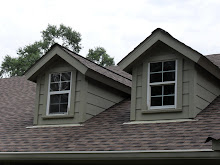Click for a FREE Estimate
It's difficult to find a leak in a metal roof. If you have a red iron building, you know the purlins run parallel to the eave. These purlins have a tray that if you have a leak at the fastener, can hold water. As the tray fills up, water runs both ways. Some of these purlins are 30ft long. The purlin acts as a gutter. The leak from a fastener, 30ft away, may drip at the butt joint. Very difficult to find, especially if you have dropped ceilings, or insulation.
First thing to do, make a drawing of the building on something you can carry with you, on the roof. Go inside and measure from the walls, where the drip is coming in. Use something that you can spot from out side. I like to pick windows, or a tree, fence, some spot of reference, so that when you are on the roof, you can easily measure it.
When you are on the roof and find the area, take some chalk and mark the area. Look at every fastener in that purlins area. Check all the ones above it. When I check leaks, I first check the field fasteners. Very seldom do I find lap fasteners leaking, so unless something just jumps out at me, I'm checking them last. I carry an impact with me, 3/8", 5/16" and 1/4"bits. You never know what type of fastener your up against. In the leak area, go ahead and pull the fastener. If you see that the rubber washer is gone, smashed paper thin or see the galvanized fastener has rust on the shank, that's a good sign of a leak.
Put a new fastener in the spot.
The photo above, is what I found on a building that was 10yrs old and leaking. The far right fastener was put on so tight, that the washer, spun out. The washer was still there, but barely. When the fastener was put so tight it spun the washer off, it dug into the metal. This caused areas of rust on the metal. The middle fastener was paper thin. It was very tight, to the point it had to be replaced. After replacing the fasteners, 30ft both ways from the leak area, I located the rusty fasteners and solved the problem.
It's difficult to find these leaks. Very hard to guarantee you have it solved sometimes, but always put it in writing. Homes are just as difficult and you need to try at all cost, not to incur any panel changing. Be prepared for some water clear sealant, where needed and close as possible fastener color when you have to change them. Wood framed properties can be a problem when you find the leaking fastener. It normally has leaked enough, the wood isn't going to hold a new fastener. Increasing the diameter of the fastener works, sometimes, but not always. If there is attic access, I take a block of wood and screw it to the bottom side of the purlin or decking. Put a longer fastener in and your fine. If its just a little loose from leaking, take some round, wood, toothpicks and put them next to the fastener and screw it in. I've done this many times with great success.
I am asked about longevity of metal roofs vs. shingle, tile, composite. They all have their good points. Foot traffic, fading, structure movement, trees, temperature changes, dirt etc. These all have an effect on all roofing. I find just as many calls for metal roof leaks, as I do shingle roof leaks. Tile roof leaks are generally the most expensive. All roofing products will require some maintenance over the years. Just be prepared to do a little maintenance before you have a major issue.
Roof Master Ask us for help
Texas Discount Roofing LLC.
discountroofing@gmail.com
tm
Subscribe to:
Post Comments (Atom)




1 comment:
Great post! I really enjoyed reading this and learned something new today.
roof contractors trumbull ct
Post a Comment